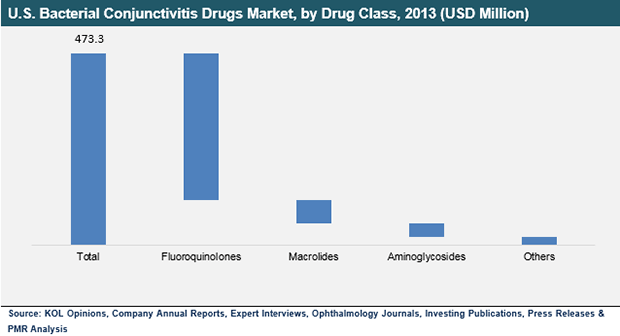Bacterial Conjunctivitis Drugs Market Segmented By Conjunctivitis Drugs, Bacterial Conjunctivitis, Viral Conjunctivitis Pipeline Drugs, Conjunctivitis Therapeutics, Acute Conjunctivitis Treatment, Bacterial Conjunctivitis Treatment
Industry: Healthcare
Published Date: July-2015
Format: PPT*, PDF, EXCEL
Delivery Timelines: Contact Sales
Number of Pages: 117
Report ID: PMRREP5192
Conjunctivitis, which is medically termed as inflammation of the membrane that covers the outermost layer of an eye, can be infective, allergic, or irritant-driven.
However, infective conjunctivitis - especially bacterial, is the most commonly observed type among the three. The global bacterial conjunctivitis drugs market is highly uncertain and is foreseen to witness sluggish to declining growth in the near future.
In 2013, the global market for bacterial conjunctivitis drugs recorded a value of US$ 473.3 Mn. The market is currently exhibiting a sluggish growth but is expected to witness a decline during the next few years and the revenues may drop down to US$ 439.8 Mn through to 2024.
PMR estimates CAGR of 2.7% for 2012-2018; however it is likely to dwindle down to -3.73% during the next half of the forecast period i.e. 2018-2024.
Recently, Healio (the U.S.) indicated that nearly 5 million people in the U.S. are inflicted by acute bacterial conjunctivitis, each year. Moreover, a recent survey published in the JAMA (Journal of the American Medical Association) states that over 50% of the conjunctivitis cases in the U.S. are of bacterial conjunctivitis.
The aforementioned figures clarify that it is one of the most common eye problems affecting people of all ages across the U.S. Such higher prevalence of the disease definitely prompts at increasing demand for effective drugs against bacterial conjunctivitis. However, the market for bacterial conjunctivitis drugs is witnessing a declining growth and the revenues may continue to drop over the forecast period.
Most of the major blockbuster drug patents are on the verge of expiring, which is the primary restraint to the market growth. Key blockbuster drugs that are due for expiry, include Moxeza, Besivance, Vigamox, and Zymaxid.
Besides a challenge posed by the loss of exclusivity of patents, the market also faces a restrain due to dearth of novel compounds available for preclinical and clinical examination. Only a few investigations against bacterial conjunctivitis and drug approvals are currently in the pipeline.
Moreover, following the drug expiry issue, physicians have been prescribing a wide range of affordable generic medications since the past few years. This is another important factor responsible for slumped bacterial conjunctivitis drugs market across the U.S. Physicians, ophthalmologists, and optometrists generally prescribe antibiotics in the form of medications, eye drops, or ointments.
However people are aware of the fact that conjunctivitis is usually acute, self-limiting, and does not cause a serious health issue. Moreover, it can also be treated and cured on its own within a few days. Awareness about this may also detain the demand for bacterial conjunctivitis drugs in the market.

The U.S. bacterial conjunctivitis drugs market is segmented on the basis of drug class into four key segments.
In the Fluoroquinolones class, there are six key sub-segments, including Ciprofloxacin, Ofloxacin, Levofloxacin, Moxifloxacin, Gatifloxacin, and Besifloxacin.
In the class of Aminoglycosides, there are Tobramycin and Gentamycin. The Macrolides class also has two sub-segments i.e. Erythromycin and Azithromycin. In the ‘others’ segment, there are a few common drugs, such as bacitracin, ceftriaxone, and fusidic acid. Owing to higher efficacy and broad spectrum activity against conjunctivitis causing bacteria, Fluoroquinolones are the most widely recommended class of drugs.
This segment registered over 70% share of the U.S. market in 2013. This class of drugs will however witness a heavy collapse in terms of sales and thereby a substantial drop in the CAGR over the forecast period.
From 4.9% estimated over 2012-2018, the Fluoroquinolones segment is expected to take a downturn to a CAGR of -8.1% during 2018-2024. Vancomycin ophthalmic ointment is one of the medications that are currently in the clinical trial pipeline and a few more are pending for approval.
The U.S. market for bacterial conjunctivitis drugs is highly fragmented and competitive. While the marketplace comprises existing as well as emerging small and large players, competition among them is intense despite the market is gradually approaching a debacle.
Some of the prominent companies in the market include Bayer AG, Merck & Co., Inc., Pfizer, Inc., Novartis AG, Hoffman-La Roche, Ltd., Akorn, Inc., Actavis plc, Perrigo Company plc, Valeant Pharmaceuticals International, Inc., and Santen Pharmaceutical Co., Ltd.
To know more about delivery timeline for this report Contact Sales

Major organizations profiled in this report include: